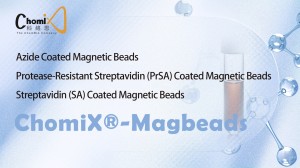Get your free samples today.

Products
ChomiX®-Magbeads Protease-resistant Streptavidin (prSA) Coated Magnetic Beads
Cat. No.:CMXR-000002
Product Name:ChomiX®-Magbeads Protease-resistant Streptavidin (prSA) Coated Magnetic Beads
Product Introduction
ChomiX®-Magbeads Protease-resistant Streptavidin (prSA) Coated Magnetic Beads are designed with chemically modified streptavidin, where lysine and arginine residues are chemically sealed. This modification does not affect beads binding to biotinylated proteins while preventing enzymatic degradation by Trypsin and LysC proteases. In mass spectrometry-based proteomics studies, Trypsin and LysC proteases are frequently used for protein digestion. To avoid sample loss, researchers directly perform on-bead enzymatic digestion in streptavidin magnetic bead systems loaded with biotinylated proteins.
However, this enzymatic digestion process also generates a large amount of streptavidin-derived peptides, which seriously interfere with the detection of low abundance peptides in subsequent mass spectrometry analysis.
Therefore, the development of ChomiX®-Magbeads Protease-resistant Streptavidin (prSA) Coated Magnetic Beads can greatly reduce this interference, which is highly suitable for direct enzymatic digestion of biotinylated proteins loaded on magnetic beads, and can be widely used in chemical proteomics and protein-protein interaction experiments in cells such as APEX and BioID.
The beads have a concentration of 10 mg/ml and a particle size of 1.0 μ m, with high streptavidin loading capacity(approximately 50 μ g / 1mg ) and extremely high hydrophilicity. Their superparamagnetic properties guarantee rapid magnetic response. They also possess excellent redispersion stability and magnetic stability, effectively ensuring high protein binding rate, low non-specific adsorption, reaction uniformity and detection consistency.
Literature Case
The magnetic beads are used to enrich and extract biotinylated proteins from the proteome, followed by direct on-bead digestion and identification by high-resolution mass spectrometry. Compared with the conventional streptavidin beads (wtS), the protease-resistant streptavidin beads (prS) samples show a barely detectable amount of streptavidin-derived peptides in the samples(Figure 1).
When applied in BioID experiments to identify SEC61B interacting proteins in HeLa cells, prS can identify 362 proteins, with an overall protein signal intensity about 10 times higher than wtS (Figure 2). The data are sourced from the literature (Molecular Systems Biology, 2020).

Figure 1: Base peak chromatograms of the peptides in samples after enrichment of wtS (left) or prS (right).
The corresponding intensities of the three representative peptides (m / z = 603.3,655.3,1018.0) generated from on-bead digested streptavidin are shown in the lower panel (XIC).

Figure 2: Number and intensity of SEC61B interacting proteins identified by conventional streptavidin wtS and prS.
Note
1. Before the first use, fully vortex and mix well to prevent changing the magnetic bead concentration. Avoid prolonged ultrasound to prevent damage to the surface of magnetic beads.
2. The bead storage solution contains low concentrations of small molecule antimicrobial, Prior to use, perform magnetic separation and washing 2-3 times with pure water or buffer solution. Use the beads as soon as possible to avoid long storage.
3. Store at 4℃, and avoid freeze- thaw during the use.

